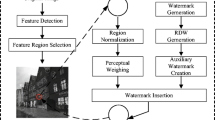Abstract
In order to improve the JPEG compression resistant performance of the current steganogrpahy algorithms resisting statistic detection, an adaptive steganography algorithm resisting JPEG compression and detection based on dither modulation is proposed. Utilizing the adaptive dither modulation algorithm based on the quantization tables, the embedding domains resisting JPEG compression for spatial images and JPEG images are determined separately. Then the embedding cost function is constructed by the embedding costs calculation algorithm based on side information. Finally, the RS coding is combined with the STCs to realize the minimum costs messages embedding while improving the correct rates of the extracted messages after JPEG compression. The experimental results demonstrate that the algorithm can be applied to both spatial images and JPEG images. Compared with the current S-UNIWARD steganography, the message extraction error rates of the proposed algorithm after JPEG compression decrease from about 50 % to nearly 0; compared with the current JPEG compression and detection resistant steganography algorithms, the proposed algorithm not only possesses the comparable JPEG compression resistant ability, but also has a stronger detection resistant performance and a higher operation efficiency.













Similar content being viewed by others
References
Cheddad A, Condell J, Curran K et al (2010) Digital image steganography: Survey and analysis of current methods. Signal Process 90(3):727–752
Chen B, Wornell GW (2001) Quantization index Modulation: a class of provably good methods for digital watermarking and information embedding. IEEE Trans Inf Theory 47(4):1423–1443
Denemark T, Fridrich J (2015) Side-informed steganography with additive distortion. In: Proceedings of International Workshop on Information Forensics and Security (WIFS), IEEE, pp 1–6
Filler T, Fridrich J (2011) Design of adaptive steganographic schemes for digital images. In: Proceedings of SPIE - The International Society for Optical Engineering, 7880:0F-0F-14
Filler T, Judas J, Fridrich J (2010) Minimizing Embedding Impact in Steganography Using Trellis-coded Quantization. In: Proceedings of SPIE - The International Society for Optical Engineering, (7541): 175-178
Filler T, Judas J, Fridrich J (2011) Minimizing additive distortion in steganography using syndrome-trellis codes. IEEE Trans Inf Forensics Secur 6(3):920–935
Holub V, Fridrich J (2012) Designing steganographic distortion using directional filters. In: Proceedings of IEEE Workshop on Information Forensic and Security, pp 234–239
Holub V, Fridrich J (2013) Digital steganography using universal distortion function. In: Proceedings of the 15th ACM International Workshop on Information Hiding, pp 59–68
Kodovský J, Fridrich J (2009) Calibration revisited. In: Proceedings of the 11th Workshop on Multimedia and Security. ACM, pp 63–74
Katzenbeisser S, Petitcolas FA (2000) Information hiding techniques for steganography and digital watermarking. Artech House, Inc
Luo W, Heileman GL, Pizano CE (2002) Fast and robust watermarking of JPEG files. In: Proceedings of the Fifth IEEE Southwest Symposium, pp 158–162
Liu W, Liu G, Dai Y (2015) Damage-resistance matrix embedding framework: the contradiction between robustness and embedding efficiency. Security and Communication Networks 8(9):1636–1647
Li B, Wang M, Huang J et al (2014) A new cost function for spatial image steganography. In: Proceedings of International Conference on Image Processing (ICIP), IEEE, pp 4206–4210
Li C, Zhang Z, Wang Y et al (2015) Dither modulation of significant amplitude difference for wavelet based robust watermarking. Neurocomputing 166(C):404–415
Maity SP, Maity S, Sil J et al (2013) Collusion Resilient Spread Spectrum Watermarking in M-band Wavelets Using GA-fuzzy Hybridization. J Syst Softw 86 (1):47–59
Miyazaki A, Okamoto A (2002) Analysis of watermarking systems in the frequency domain and its application to design of robust watermarking systems. IEICE Trans Fundam Electron Commun Comput Sci 85(1):117–124
Pevný T, Bas P, Fridrich J (2010) Steganalysis by subtractive pixel adjacency matrix. IEEE Trans Inf Forensics Secur 5(2):215–224
Pevný T, Fridrich J (2008) Multiclass detector of current steganographic methods for JPEG format. IEEE Trans Inf Forensics Secur 3(4):635–650
Pevný T, Filler T, Bas P (2010) Using High-dimensional Image Models to Perform Highly Undetectable Steganography. In: Proceedings of the 12th ACM International Workshop on Information Hiding, pp 161–177
Sedighi V, Cogranne R, Fridrich J (2016) Content-Adaptive Steganography by minimizing statistical detectability. IEEE Trans Inf Forensics Secur 11(2):221–234
Shen C, Zhang H, Feng D et al (2007) Survey of information security. Science in China Series F: Information Sciences 50(3):273–298
Tsai JS, Huang WB, Kuo YH (2011) On the selection of optimal feature region set for robust digital image watermarking. IEEE Trans Image Process 20(3):735–743
Tsai J, Huang W, Kuo Y et al (2012) Joint Robustness and Security Enhancement for Feature-based Image Watermarking Using Invariant Feature Regions. Signal Process. 92(6):1431–1445
Wang X, Niu P, Yang H et al (2014) A new robust color image watermarking using local quaternion exponent moments. Inf Sci 277:731–754
Xiao J, Wang Y (2009) Adaptive dither modulation image watermarking algorithm. J Electron Inf Technol 31(3):552–555
Zhang Y, Luo X, Yang C et al (2015) A JPEG-compression Resistant Adaptive Steganography Based on Relative Relationship between DCT Coefficients. In: Proceedings of the IEEE 10th International Conference on Availability, Reliability and Security (ARES), pp 461–466
Zhang Y, Luo X, Yang C et al (2016) Joint JPEG compression and detection resistant performance enhancement for adaptive steganography using feature regions selection. Multimedia Tools and Applications, 1–20
Zhang Y, Luo X, Yang C et al (2016) A framework of adaptive steganography resisting JPEG compression and detection. Security and Communication Networks 9 (15):2957–2971
Acknowledgments
This work was supported by the National Nature Science Foundation of China (Grant No. U1636219, 61379151, 61401512, and 61572052), the Excellent Youth Foundation of Henan Province of China (No. 144100510001).
Author information
Authors and Affiliations
Corresponding author
Rights and permissions
About this article
Cite this article
Zhang, Y., Zhu, X., Qin, C. et al. Dither modulation based adaptive steganography resisting jpeg compression and statistic detection. Multimed Tools Appl 77, 17913–17935 (2018). https://doi.org/10.1007/s11042-017-4506-3
Received:
Revised:
Accepted:
Published:
Issue Date:
DOI: https://doi.org/10.1007/s11042-017-4506-3




